Table of Contents
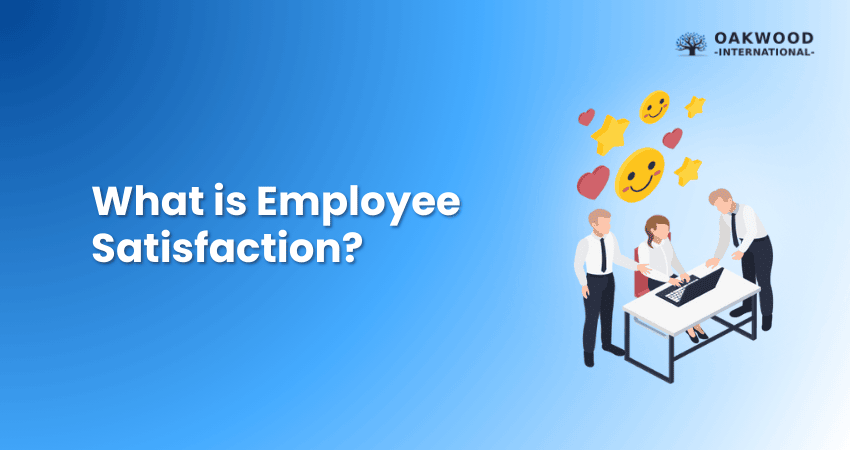

Imagine starting your day at a workplace where you feel valued, supported, and motivated. That’s what every employee dreams of; and it begins with understanding What is Employee Satisfaction. It’s about creating an environment where people don’t just work for a paycheck but feel truly connected to what they do. When satisfaction is high, productivity rises, and turnover drops.
In this blog, we’ll explore What is Employee Satisfaction and why it matters. We’ll cover its importance, key factors, and simple ways to improve it. We’ll also discuss measurement challenges and how they differ from employee engagement to help you build a happier, motivated workforce.
Table of Contents
1) What is Employee Satisfaction?
2) Why is Employee Satisfaction Important?
3) Factors That Contribute to Employee Satisfaction
4) How do you Achieve Employee Satisfaction?
5) Challenges in Measuring Employee Satisfaction
6) Employee Satisfaction vs Employee Engagement: What’s the Difference?
7) Conclusion
What is Employee Satisfaction?
Employee Satisfaction means how happy and comfortable employees feel with their job, workplace, and company. It shows how positive and healthy the organisation is. Things like pay, work-life balance, growth, and company culture affect it. When employees are satisfied, they work better, stay longer, and care more about their jobs.
These are the factors that help keep employees happy and satisfied:
1) Pay & Benefits: Fair salary and perks make employees feel valued.
2) Work Environment: A positive and well-equipped workplace boosts happiness.
3) Work-life Balance: Flexible schedules and personal time reduce stress.
4) Career Growth: Learning and promotion opportunities keep employees motivated.
5) Job Role: Enjoyable tasks that match skills increase job satisfaction.
6) Company Culture: Supportive leaders and a respectful culture ensure employee security.
Why is Employee Satisfaction Important?
Employee Satisfaction is vital as it boosts productivity, improves work quality, increases retention, reduces turnover, enhances customer service, and creates a positive workplace. Let’s explore three key reasons why it matters:
1) Workplace Efficiency
Satisfied employees are more productive and efficient. They work harder, complete tasks on time, and are willing to go the extra mile. A positive work environment encourages employees to focus on their goals without stress or frustration.
2) Employee Retention
When employees feel valued and supported, they are less likely to leave the company. High Employee Satisfaction reduces turnover, saving businesses the cost of hiring and training new people. Retaining talented employees also keeps company performance consistent.
3) Customer Satisfaction
Happy employees deliver better customer service. They interact more positively with clients, handle problems calmly, and create a better customer experience. Satisfied employees make satisfied customers, which helps grow the business.
Shape your organisational success through our HR Strategy Training – Join today!
Factors That Contribute to Employee Satisfaction
Several factors influence how satisfied employees feel at work. Employers need to focus on these areas to create a positive and motivating workplace. These are the factors that contribute to Employee Satisfaction:
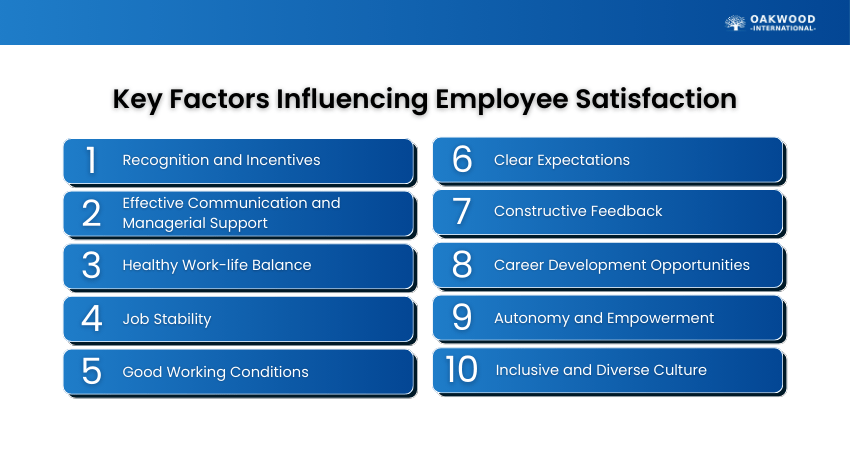
1) Recognition and Incentives
Employees want their hard work to be appreciated. Recognising achievements through awards, bonuses, promotions, or even simple thank-you motivates employees and makes them feel valued.
Tip: Use regular shout-outs, appreciation emails, or reward systems to recognise both big and small achievements.
2) Effective Communication and Managerial Support
Clear and open communication between managers and employees builds trust. When managers provide guidance, listen to concerns, and offer solutions, employees feel supported and respected.
Tip: Schedule weekly one-on-one check-ins or team updates to keep communication open and transparent.
3) Healthy Work-life Balance
Employees perform better when they have time for personal life and family. Companies that offer flexible working hours, remote work options, or mental health support reduce burnout and improve Employee Satisfaction.
Tip: Offer flexible schedules, remote work opportunities, or wellness programmes to support a better balance.
4) Job Stability
Knowing their job is secure gives employees peace of mind. Job security builds confidence and loyalty, reducing stress and encouraging employees to perform at their best. When employees feel safe in their roles, they can focus more on their work and goals.
Tip: Be transparent about company performance and growth plans to reassure employees about stability.
5) Good Working Conditions
A safe, comfortable, and friendly workplace has a huge impact on employee happiness. Proper equipment, clean spaces, and a supportive culture all create a better work experience. Better working conditions also make employees feel respected and valued.
Tip: Invest in ergonomic furniture, proper tools, and clean, organised spaces to improve comfort and productivity.
6) Clear Expectations
Employees need to know what is expected of them. When job roles, responsibilities, and goals are clearly defined, it reduces confusion and helps employees focus on their work. Clarity helps employees stay confident and complete their tasks more effectively.
Tip: Provide clear job descriptions and share defined performance goals during onboarding and reviews.
7) Constructive Feedback
Employees grow when they receive helpful feedback. Managers who provide guidance on improving performance while appreciating strengths build confidence and motivation. Regular feedback also helps employees understand how to improve and succeed.
Tip: Use a balance of praise and constructive suggestions to keep employees motivated and supported.
8) Career Development Opportunities
Employees value opportunities to develop their knowledge and skills. Providing training, mentorship, and promotion pathways keeps them engaged and motivated. A workplace that supports growth encourages loyalty and long-term commitment.
Tip: Provide continuous learning programmes, mentorship schemes, and clear promotion tracks.
9) Autonomy and Empowerment
When employees have decision-making freedom, they feel trusted and respected. Autonomy reduces micromanagement and allows creativity to flourish. This independence boosts confidence and innovation in everyday work.
Tip: Allow flexible decision-making within roles and reduce unnecessary micromanagement.
10) Inclusive and Diverse Culture
A culture of diversity and inclusion helps employees feel accepted and valued. It promotes fairness and creates a strong sense of belonging. Such environments improve collaboration and morale across teams.
Tip: Encourage diverse hiring, celebrate cultural events, and provide inclusion training.
11) Strong Team Relationships
Positive relationships with colleagues make the workplace more enjoyable. Supportive teamwork builds trust and encourages collaboration. Strong connections reduce stress and increase job satisfaction.
Tip: Organise team-building activities and encourage cross-departmental collaboration.
12) Leadership Style
Leaders strongly influence how employees feel at work. Transparent, empathetic, and supportive leadership creates trust and motivation. A positive leadership style sets the tone for a healthy workplace culture.
Tip: Train leaders to be approachable, empathetic, and transparent.
13) Purpose and Meaning in Work
Employees are more satisfied when they see purpose in their roles. Connecting work to organisational goals gives meaning to daily tasks. This sense of purpose builds pride and commitment.
Tip: Connect daily tasks to the company’s mission and vision to build a sense of purpose.
Forecast staffing needs effectively with our Workforce Resource Planning Training – Register today!
How do you Achieve Employee Satisfaction?
Improving Employee Satisfaction takes effort, but it benefits both employees and employers. Here are simple ways to create a happier workplace:
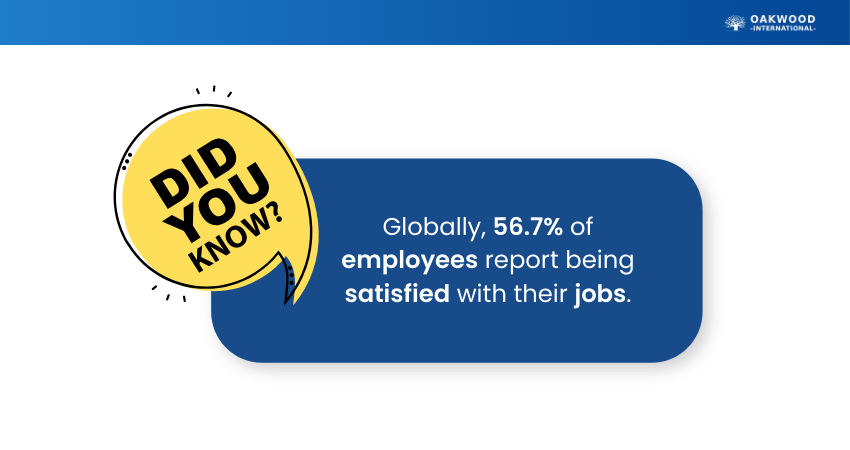
1) Set Realistic Expectations
Make sure employees clearly understand their roles and responsibilities. Avoid unrealistic deadlines and workloads that lead to stress.
Example: If a project normally takes 10 days, don’t expect it to be completed in 5. Set achievable timelines instead.
2) Recognise Good Work
Celebrate achievements, big or small. A simple appreciation email, bonus, or award can boost morale and motivation.
Example: Sending a “Star of the Month” email or giving a small gift card for outstanding performance.
3) Prioritise Long-term Development
Offer opportunities for career growth through training, mentorship, and promotions. When employees see a clear future in the company, they stay committed.
Example: Providing employees with access to leadership workshops or online certification courses.
4) Communicate More
Encourage open communication at all levels. Managers should listen, guide, and provide updates regularly to keep employees informed.
Example: Holding weekly team check-ins where employees can share updates and raise concerns.
5) Care About Employee Well-being
Support employee mental and physical health. Wellness programmes, flexible schedules, and stress management resources make employees feel cared for.
Example: Offering free counselling sessions or allowing flexible work hours to reduce stress.
6) Offer Opportunities for Learning
Provide training, workshops, and certifications to help employees develop new skills. Learning boosts confidence and keeps employees engaged.
Example: Giving employees access to platforms like LinkedIn Learning or sending them to industry-related conferences.
7) Give Frequent Feedback
Constructive and regular feedback helps employees grow. Recognise strengths and guide improvements without being overly critical.
Example: Scheduling monthly one-on-one sessions to discuss progress and offer helpful suggestions.
8) Don't Focus too Much on Perks
Free lunches and office games are nice, but not enough. Employees value respect, fair pay, and meaningful work more than extra perks.
Example: Instead of adding another snack bar, ensure employees get competitive salaries and growth opportunities.
9) Empower Employees
Give employees autonomy to make decisions in their roles. Trusting them builds confidence, creativity, and a sense of ownership.
Example: Allowing a marketing team member to create and lead a campaign instead of micromanaging every step.
Learn effective strategies to attract, develop, and retain top talent. Join our Talent Management Training today!
Challenges in Measuring Employee Satisfaction
Measuring Employee Satisfaction is important, but not always easy. Here are some challenges that often arise:
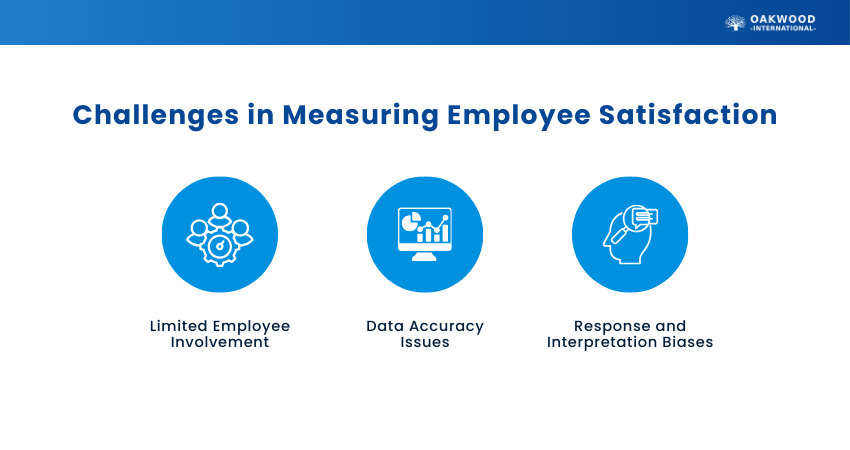
1) Limited Employee Involvement
Not everyone answers surveys. Those who skip them may feel very differently, so results may not show the full truth. Even if surveys are mandatory, answers may not always be honest. Managers can also ask for feedback in team meetings to better understand.
2) Data Accuracy Issues
When you send surveys, it matters a lot. For example, if you send them during a busy, stressful time, the answers may be negative. If you send them after a fun company event, answers may be more positive. To get fair results, send surveys at the same regular times.
3) Response and Interpretation Biases
Survey questions should be simple and neutral so employees can answer honestly. When looking at the results, managers should stay open-minded and not only see what they want to see.
Employee Satisfaction vs Employee Engagement: What’s the Difference?
Here are the detailed key differences between Employee Satisfaction and Employee Engagement:
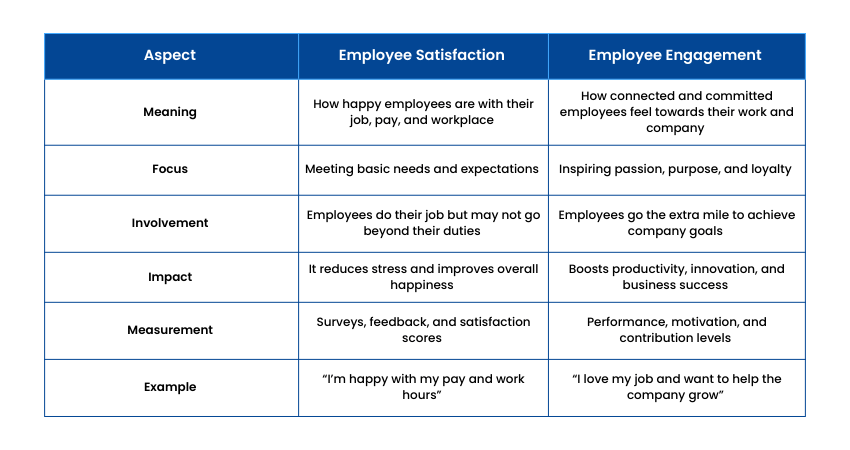
Meaning
1) Employee Satisfaction: Refers to how happy employees are with their job basics like salary, benefits, and workplace conditions. It’s about comfort and happiness with what the company provides.
2) Employee Engagement: Goes deeper, showing how emotionally committed and connected employees feel to their work and organisation. It reflects passion, motivation, and a sense of belonging.
Focus
1) Employee Satisfaction: Focuses on meeting essential needs such as fair pay, safe working conditions, and job security. It ensures employees feel their basic expectations are covered.
2) Employee Engagement: Centres on inspiring purpose, passion, and loyalty. It’s about making employees feel that their work matters and contributes to a larger mission.
Involvement
1) Employee Satisfaction: Employees generally do what is expected but may not put in extra effort beyond their role. Their focus is mainly on fulfilling assigned duties.
2) Employee Engagement: Engaged employees actively go above and beyond, taking initiative and striving to achieve organisational goals. They often display ownership and accountability.
Impact
1) Employee Satisfaction: Leads to reduced stress, improved morale, and overall happiness at work. It creates stability but may not always drive innovation.
2) Employee Engagement: Drives higher productivity, innovation, and overall business success. Engaged employees contribute actively to growth and performance improvements.
Measurement
1) Employee Satisfaction: Typically measured through surveys, feedback forms, and satisfaction scores. These tools focus on evaluating employee contentment with workplace basics.
2) Employee Engagement: Measured through performance levels, motivation, and discretionary effort (the willingness to go beyond job duties). It’s more dynamic and behaviour-oriented.
Example
1) Employee Satisfaction: “I’m happy with my pay and work hours.” This shows contentment with fundamental aspects.
2) Employee Engagement: “I love my job and want to help the company grow.” This shows passion, commitment, and alignment with company goals.
Conclusion
Understanding What is Employee Satisfaction helps create better customer experiences and drives long-term business success. When people feel valued and supported, they stay longer, perform better, and speak positively about your brand. Prioritise fair pay, respect, recognition, clear goals, and work-life balance. Regularly measure satisfaction, act on feedback, and foster trust. Satisfied teams drive stronger, sustainable results.
Learn proven strategies to improve Employee Satisfaction and retention with our Employee Engagement Training – Join now!


 Back
Back



 Back to Catagories
Back to Catagories





 + 44 7452 122728
+ 44 7452 122728










